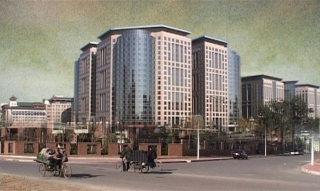Date: 28 October 2007 | Season: London Film Festival 2007 | Tags: London Film Festival
NOW WAIT FOR LAST YEAR
Sunday 28 October 2007, from 12-7pm
London BFI Southbank Studio
Rachel Reupke, Now Wait for Last Year, UK-China, 2007, 9 min (continuous loop)
In response to the rapid pace of property development in Beijing, Reupke references the visual style of architectural practice and corporate videos to present a sequence of fixed views of urban landscapes. Buildings which share the characteristics of both traditional and futuristic design are displayed, but all is not what it seems. Digital images cannot be trusted: these could be plans for future structures or computer-aided fantasy.
Rachel Reupke lives and works in London. Recent exhibitions include Land of Cockaigne, Fabrica, Brighton; Beyond the Country, Lewis Glucksman Gallery, Cork; Vidéo et après, Pompidou Centre, Paris (solo screening) and 24 Hour Fresh Air, L’Espace Croisé, Roubaix.
Now Wait for Last Year was produced as part of the Arts Council England International Fellowships Programme with Gasworks. The title is borrowed from Philip K. Dick.
PROGRAMME NOTES
NOW WAIT FOR LAST YEAR
Sunday 28 October 2007, from 12-7pm
London BFI Southbank Studio
NOW WAIT FOR LAST YEAR
Rachel Reupke, UK-China, 2007, video, colour, sound, 9 min
This video work reflects Rachel Reupke’s long-standing fascination with science fiction and the inherent problem of visualising the future.
Beijing is in the throws of a construction boom, break-neck in speed. Building sites are hemmed in by developers’ hoardings, each displaying an architect’s visualisation of what is to come in ambitious, blurry-soft style. Thousands of these billboards intrude on the streets: the future of the city rendered as illustrated inserts into the reality of its present – just as Beijing’s tourist maps pre-empt the completion of these projects, in order to keep up with the relentless pace of change. This visual overlay of proposed onto existent gives the impression that time is being compressed, and that tomorrow might actually be running concurrently with today.
Now Wait for Last Year takes the idea of these developers’ hoardings as its starting point. In a hybrid of architect’s projection and corporate video, Beijing’s buildings are presented in single-shot fixed frames, both monumental and unreal. Photographic in nature, but with visible post-production, the idea is that these images resist being located in a specific time or place. The collage aesthetic coupled with the incongruous design of some of these structures prompts the question as to whether these buildings actually exist in present day Beijing, are plans for future developments, or are sheer fantasy.
Back to top
